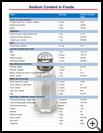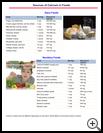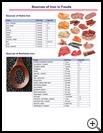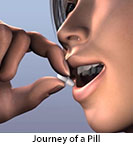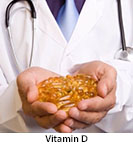
Vitamins and Minerals
________________________________________________________________________
KEY POINTS
- Vitamins and minerals are chemicals that your child’s body cannot make on its own that are needed to stay healthy.
- You can get vitamins and minerals from foods and supplements.
- Check with your healthcare provider if you think your child may not be getting all the nutrients he needs.
________________________________________________________________________
What are vitamins and minerals?
Vitamins and minerals are chemicals that your child’s body cannot make on its own that are needed to stay healthy. A healthy diet is the best way to get these nutrients. However, your child may not eat enough different foods to get all of the vitamins and minerals that he needs. Examples of children who may need to take supplements include:
- Children who do not get out in the sun may need a vitamin D supplement.
- Children who cannot absorb certain nutrients may need to take specific supplements.
- Premature babies and children who are breastfed may also need certain supplements.
You may want to add a daily multivitamin and mineral supplement to your child’s diet, but supplements are not a substitute for a healthy diet. Check with your healthcare provider, pharmacist, or dietitian before your child starts taking supplements. This is especially important if your child takes prescription medicine or is being treated for a health problem.
Choose a supplement that provides no more than 100% of the daily value for your child's age. Having too much of some supplements can cause serious problems.
Vitamin A
Vitamin A is needed for growth and for strong bones and teeth. As you grow older, it helps keep your skin and eyes healthy. Vitamin A is in liver, fish liver oils, dairy products, dark green and yellow-orange vegetables, and in fruits.
Milk and infant formulas are good sources of Vitamin A.
It is rare to get too much vitamin A from foods, but taking supplements with dosages that are too high can cause long-term health problems. Too much vitamin A can be poisonous. It may cause symptoms that include headache, itchy skin, and hair loss.
Vitamin B
Several vitamins are in the B group. They play a part in many of the processes that make the body work properly. They are needed for changing food to energy and keeping your blood, nerves, and skin healthy. Vitamins in the B group are in meats, dairy products, nuts, grains, leafy vegetables, and some fruits.
No poisonous effects have been found for most B vitamins. However, too much vitamin B6 can irritate the nerves.
Vitamin C
Vitamin C helps build healthy tissues. It also helps your body heal and may help boost your immune system. It is also an antioxidant, which means it protects against damaging chemical processes in the body. Vitamin C is found in fruits and vegetables such as citrus fruit, cantaloupes, tomatoes, potatoes, and green peppers. Taking high doses of Vitamin C can cause diarrhea.
Vitamin D
Vitamin D builds strong bones and teeth. Vitamin D is present in dairy products, infant formulas, oily fish, liver, and egg yolk. Sunlight is another source of vitamin D. Breastfed infants need to take a supplement of 400 IU of Vitamin D each day. Infants and children who drink 16 ounces or more of formula or Vitamin D fortified milk do not need to take a supplement. The American Academy of Pediatrics says that older children or teens who do not drink at least 32 ounces of vitamin D-fortified milk should take vitamin D supplements. Talk with your child’s healthcare provider about this.
Too much vitamin D can cause stomach upset, depression, and calcium deposits in the kidneys and blood vessels.
Vitamin E
Vitamin E is an antioxidant vitamin that helps the cells in your body stay healthy. It also helps the body make new red blood cells. It is in nuts, seeds, plant oils, avocados, grains, and egg yolk.
Too much vitamin E can cause stomach upset and can keep the body from absorbing vitamins A, D, and K.
Vitamin K
Vitamin K is needed to help blood clot after an injury. It also helps to keep bones healthy and help healing after a broken bone. It is found in leafy green vegetables, broccoli, vegetable oils (especially canola and soybean), egg yolk, pork, and liver. Vitamin K is also made by bacteria that live in the gut.
Large doses of vitamin K can cause allergic reactions in some people, such as itching and rash.
Calcium
Calcium is a mineral needed for strong bones. Milk and dairy products are some of the best sources of calcium. You can also buy calcium fortified juices, cereals, and soy foods. Green vegetables, such as broccoli and kale provide calcium too.
Babies under 1 year old should get enough calcium from breast milk or iron-fortified formula. Children 1 to 2 years old should drink whole milk because certain fats are also needed for development during this early stage. Between the ages of 2 and 5 years, gradually switch from whole milk to low-fat milk or fat-free milk.
Potassium
Potassium helps the body to break down and use carbohydrates. Potassium also helps control the electrical activity of the heart. Meat, fish, dairy products, and many fruits and vegetables provide potassium.
Potassium helps build muscle and is needed for normal growth. Most children get all that they need from food. Some children with kidney problems may need to take a supplement.
Sodium
Salt in the diet is a mineral called sodium. Sodium helps the body keep the right balance of fluids. The right fluid balance helps the body keep the right blood pressure, keeps your child from losing too much fluid (dehydration), and keeps your child’s kidneys healthy. Too much salt in the diet can cause swelling of the hands, feet, and belly, or raise your child’s blood pressure. This puts your child at risk for heart disease, especially if your child is overweight. Too little or too much sodium in your child’s blood can affect brain, heart, nerve, and muscle cells.
Many children eat more sodium than they need. Many soups, frozen dinners, lunch meats, instant rice and noodle mixes, and fast foods have a lot of sodium. Serve more fresh, whole foods, like fresh fruits and vegetables, which have very little sodium. Use little or no salt when you prepare food and do not add salt to food at the table.
Iron
Iron is a mineral that is important to all body cells. Blood cells need iron to bring oxygen to body cells. Your child can get iron deficiency anemia if he doesn’t get enough iron. Iron is found in meat, poultry, fish, fruits, vegetables, grains, nuts, legumes, and iron-enriched foods.
It is better for children to eat foods high in iron rather than to take a supplement. Too much iron can poison a child.
Zinc
Zinc is an important mineral that helps the body use protein, heal wounds, and have a healthy immune system. It helps with growth, especially during the teen years. Foods high in zinc include meats, seafood, dairy products, whole grains, breads and fortified cereals, nuts and dried beans.
Too much zinc can cause nausea, vomiting, loss of appetite, diarrhea, and headaches. It can also affect the way antibiotics and other medicines work.
Fluoride
Most children get enough fluoride from the water they drink, because most city water supplies are treated with fluoride. Well water and filtered or bottled water often do not contain fluoride. Infant formulas do not contain enough fluoride. Talk to your healthcare provider before giving fluoride supplements. It is usually better to have your child drink water that is supplemented with fluoride instead of giving extra fluoride drops or supplements. Too much fluoride can make your child's teeth turn brown.
How do I know if my child is eating a healthy diet?
If your child feels good, his skin is clear, and he has plenty of energy, your child is probably eating a healthy diet. If your child is not getting enough vitamins or minerals, he may have symptoms such as:
- Rashes
- A painful, swollen tongue
- Tiredness
- Irritability
- Depression
- Pale skin
- Trouble focusing
Check with your healthcare provider if you think your child may not be getting all the nutrients he needs.
Last modified: 2015-03-02
Last reviewed: 2017-03-01

